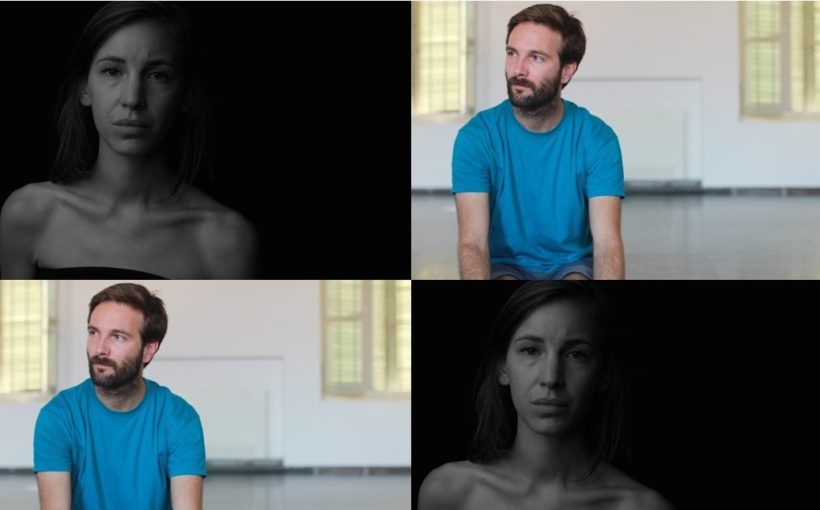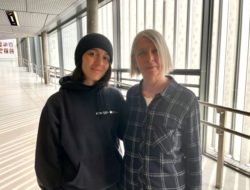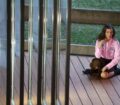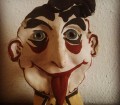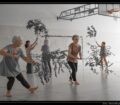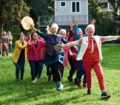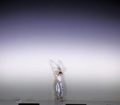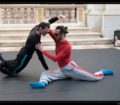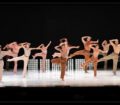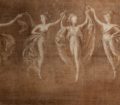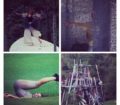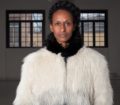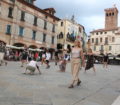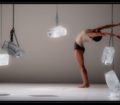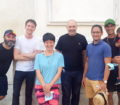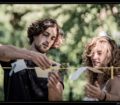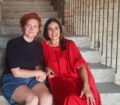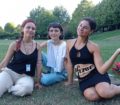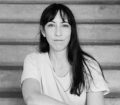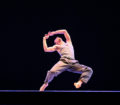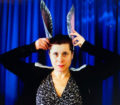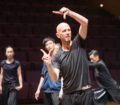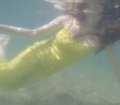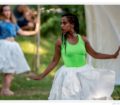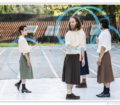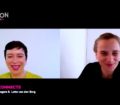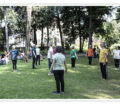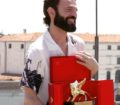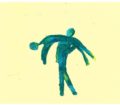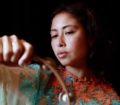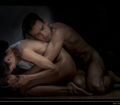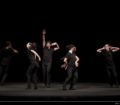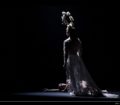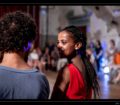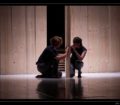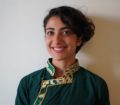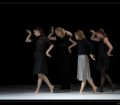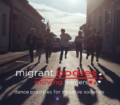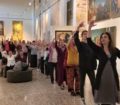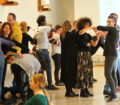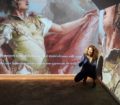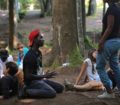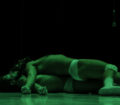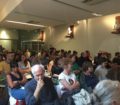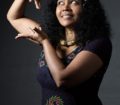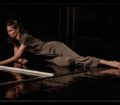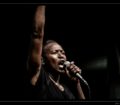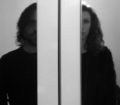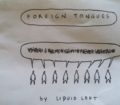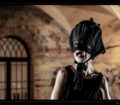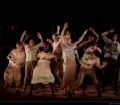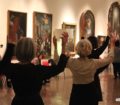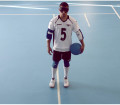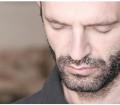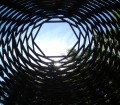We had seen Stefania Tansini this summer dance for BMotion Danza 2021 in her incisive solo “La grazia del terribile” (the grace of the terrible). A short cameo, a deadly spark, embodied by Tansini’s own words:
“Dance, a dancing body does not express the world. It expresses what the dancer knows about the world. […] The dancer’s body […] can be a gateway to a discourse that transcends it”.
The vivid beginning of her solo, sculpted through precise and meditated poses, had melted into a dark and progressive disintegration of form, wittingly culminating in a disorienting bewilderment. Her body shaken by jolts, trembling, that dense liquid flow of hers had been cast back over the audience like a towering and terrifying shadow, a hallucination, a daunting double. Today we turn the tables on that artistic encounter, interviewing this artist via Zoom and “compelling” her to verbalise her magmatic dance.
Together with her, on the same Zoom call, was Francesco Dalmasso, a brilliant, creative and versatile dance-maker and curator, selected by Lavanderia a Vapore as a representative of the Piedmont and Italian scene for part of the Boarding Pass Plus Dance project.
The opportunity for such a crackling digital conversation sprang from their joint participation in Cellule d’Essai, an initiative launched by choreographers Lola Maury and Benjamin Coyle in order for European artists and choreographers “to meditate on the nature of the dancer’s work and its processes” and which took place in Lyon at the Maison de la Danse.
Stefania, to break the ice, could you to tell us about the salient junctures in your training?
S.T. Among those that I personally consider formative are first and foremost my experiences in the Academy, at Paolo Grassi, with artists such as Dominique Dupuy, Maria Consagra, Enzo Cosimi. Then, outside the Academy, working with Luca Vegetti and Simona Bertozzi was key. With the latter I have built a very deep and lasting relationship. Then I met Romeo Castellucci and was also lucky enough to work with Cindy Van Hacken as a dancer. To date, as an interpreter, I work for Motus.
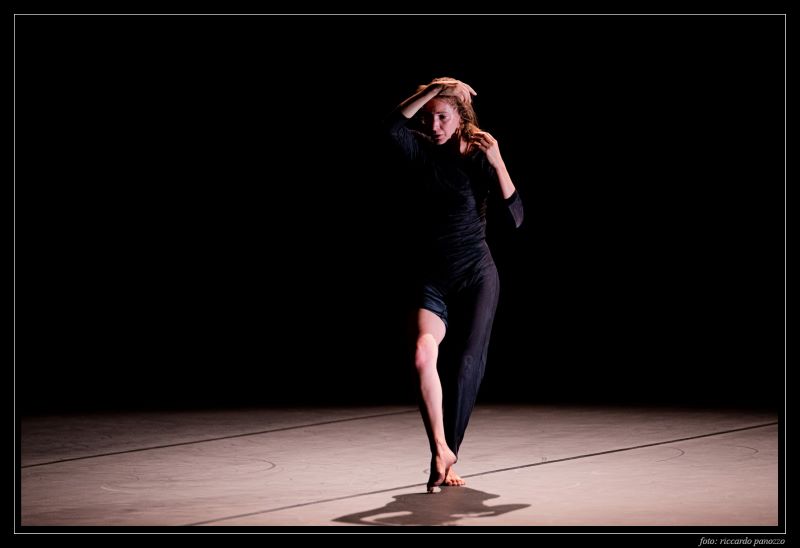
Stefania Tansini in “La grazia del Terribile”, BMotion Danza 2021. Photo by Riccardo Panozzo
It is intriguing that you come from artistic gymnastics. What sparked off your attraction to dance?
S.T. I was doing artistic gymnastics in a gym, I must have been seven years old. I loved the parallel bars, the beams… I was really physical. At a certain point, in this gym, they also started to introduce dance lessons. Yet in these early dance classes I was bored to death, because it was an inane form of dance, where everything became an aesthetic pose. Subsequently I enrolled in another dance school were I was able to rediscover the physicality that I had lacked during that first amateur course. Of course, gymnastics has quite different principles to dance. But, due to the approach I have towards the body, for me it was merely a change of form: I have always continued to search for those places and possibilities in which my body can express itself in a “dense” way.
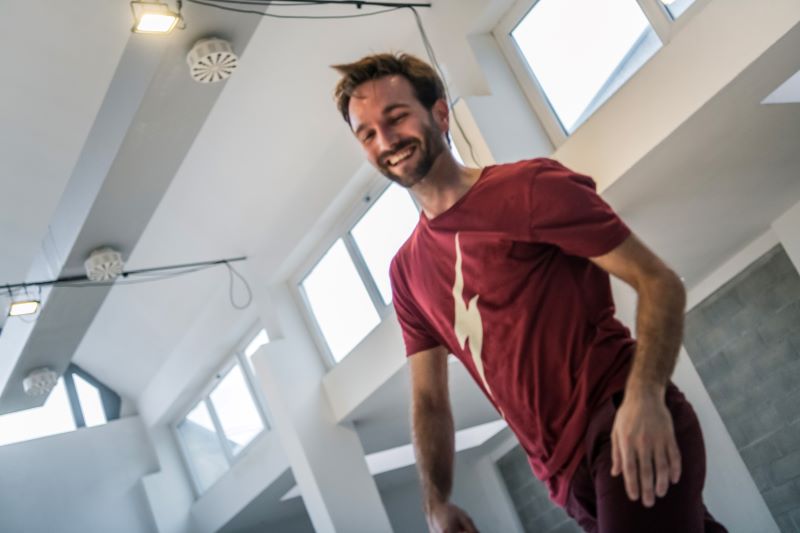
Francesco Dalmasso. Photo by Andrea Macchia
Turning to you Francesco, how was your love for dance born? Can you briefly outline the stages in your training?
F.D. I began when I was pretty small, I must have been around six or seven. Mine is a common story. A next-door neighbour had a dance school. One evening she came around for dinner. She told me: “If you want, you can come to class every now and then”. And that’s how it started. I am originally from a small village in the Langhe area, but then, also thanks to the open-mindedness of one teacher who had always encouraged me to travel, I went off to Turin and Florence to study. My most important experience, however, was in Holland. There I studied at ArtEZ, where I attained my bachelor’s degree in dance. Then travelled around Europe for a few years, mainly working as an interpreter; France, Germany, Lithuania, England and Wales. But since 2015 I have been back working in Turin.
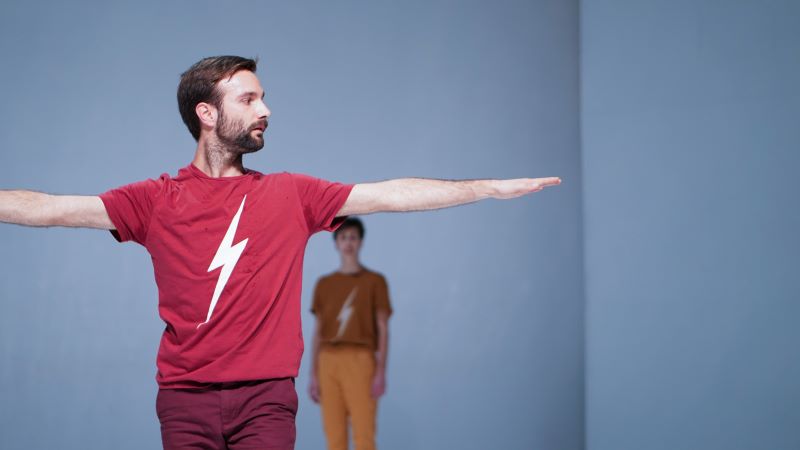
Francesco Dalmasso and Elisa D’Amico in “Virgolette”, NAOcrea 2019. Photo by Bing Xuan Li.
There has always been an element in my approach to dance that I think had been encouraged by the Dutch context during my studies there. In fact, I look at the world of dance, which is the heart of my interest and study, from different points of view: historically and mainly as an interpreter, then as an author and teacher and, in recent years, above all as a curator and organiser. I am thinking of projects such as Shared Training Torino, a platform for portioning out practices, as well as WorkSpace Ricerca X, which deals with artistic research. Having the same subject yet being able to approach it from different angles, slipping into diverse roles, never ceases to stimulate me.

Stefania Tansini in “La grazia del Terribile”, BMotion Danza 2021. Photo by Riccardo Panozzo
Stefania, you too “look two ways”: as interpreter, yet in the other direction as author and choreographer.
S.T. They are two different gazes, that of the author and that of the interpreter, each following different rules while playing the same game. This is very interesting to me: I feel that my brain functions differently when I am dancing. The situation changes, the point of view changes: as an interpreter you are inside the work, you are inside the perception that others have of you. The choreographic gaze, on the other hand, looks at the bodies of others, externally. I am interested in the choreographic and authorial gaze, because it seems to me a particularly rich mode of connection between the bodies that I observe and between the space of my body and that of others. The body already has an almost dramaturgical dimension in it but the gaze of the choreographer “explodes” this dimension, amplifies it. It is as if instead of merely completing the first chapter of a book, you continue reading, and then go on to read more books.
What projects are you currently working on?
S.T. I’m working on a modular project called My Body. It splits in two. On the one hand, there is My Body as a solo piece [which debuted at the Romaeuropa Festival on 30 October, 2021: Ed.]. On the other is a piece entitled My Body My Space. We make up a trio that has a series of residences planned together until the end of 2021, because we won the “Toscana Terra Accogliente” bid. The preview will be in spring 2022. These are two concrete projects in which I can crystallise my research as well as my vision on the body and on space.

Francesco Dalmasso in “TOWARDS per Isolotto”, Cantieri Culturali Isolotto, 2021. Photo by Francesca Ugolini
F.D. I am in the initial phase of a project called Towards, together with Elisa D’Amico, a colleague with whom I have been working with for several years. The piece focuses on the concept of moving towards. It stems from the covid lockdown: from the desire to finally be able to leave the house; to go towards other spaces, towards other bodies, towards other thoughts. For the moment its developmental horizon is remarkably broad: meetings, interviews, shared writings on disk drives, physical practices, work for the stage…
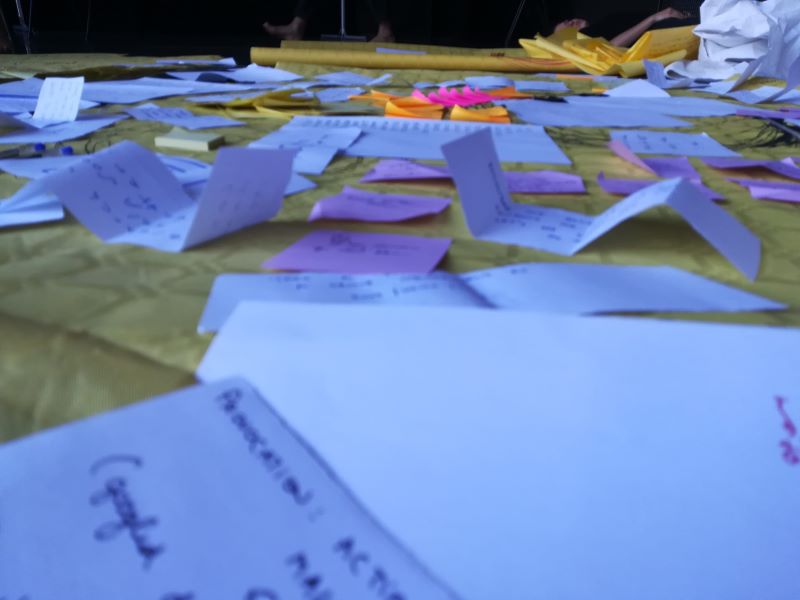
Boarding Pass Plus Dance, Lyon, 2021
Coming now to your recent experience of working alongside Lola Maury and Benjamin Coyle at the Maison de la Dance in Lyon for the European project Boarding Pass Plus Dance. How did it go?
F.D. In those three days in Lyon, the proposed basic structure was that of the mail-box, where each of us could post slips of paper with our own thoughts. It initiated as an ice-breaking exercise and then became a way of working to propose questions to the group to be discussed and subsequently “spatialised”.
S.T. There were many things that emerged so the risk was that we would get lost in an infinite branching, because everything became a potential starting point to work from. But even just hinting at these things, with the awareness that you couldn’t go into them all, was a symptom of the fact that the approach to these three days really worked. It was an extremely open and free approach, but also very lucid, pragmatic and inclusive. It included the ability to disagree with each other, to decide which issues to drop and which to address.
There were artists who came from other parts of Europe: some from London, some from Belgium, some from Spain, some from France. It was interesting to observe how our different cultural backgrounds expressed themselves, in spite of ourselves, through us, our bodies and our words. Perhaps this created distances, but it nevertheless allowed for encounters through both words and actions and also just “being”. As far as I’m concerned, we welcomed each other, despite the differences. Despite everything, there was a dialogue on several levels, sincere and very genuine, within which our entire lives lay. All the people who came – myself included – needed to be there, because dance is and has always been our life.
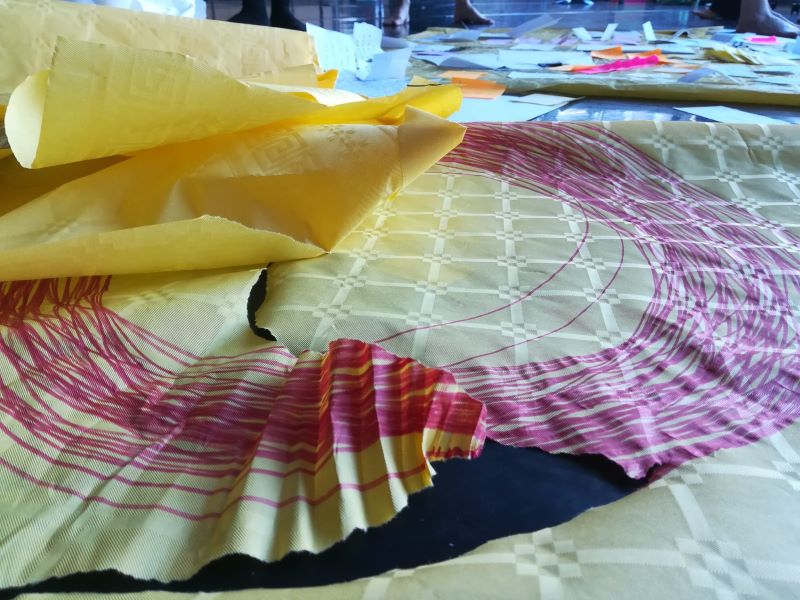
Boarding Pass Plus Dance, Lyon, 2021
The fact of hailing from half of Europe, in addition to having produced a “collision” of cultural backgrounds, did it also give you the feeling that there might be a common grammar in European contemporary dance, a common thread, for example in terms of content? Or didn’t you detect any such commonality at all? Is there a “European dance” – forgive the hyperbole – or is it catastrophically misguided to even broach the topic?
S.T. The expression “European dance” does indeed seem anomalous to me, even to utter. Concretely, the common ground of encounter is the condition in which we find ourselves working. The commonplace is: “we are all in the same boat”. All of us, as independent artists, are currently navigating via sight, in a very complex system, which is that of production but which also includes non-production and laboratory phases; which is itself made up of interpreters but also of non-interpreters; which includes “dance” yet also the “performance” and, for some, even the “show”. Together we deliberated upon what we are doing. And this did not lead to an univocal answer but a rather ragged and complex one, determined by multiple factors, not just related to dance, to doing dance, to entering into a rehearsal space in order to move, but also to the system that revolves around dance and that, inevitably, influences what we do.
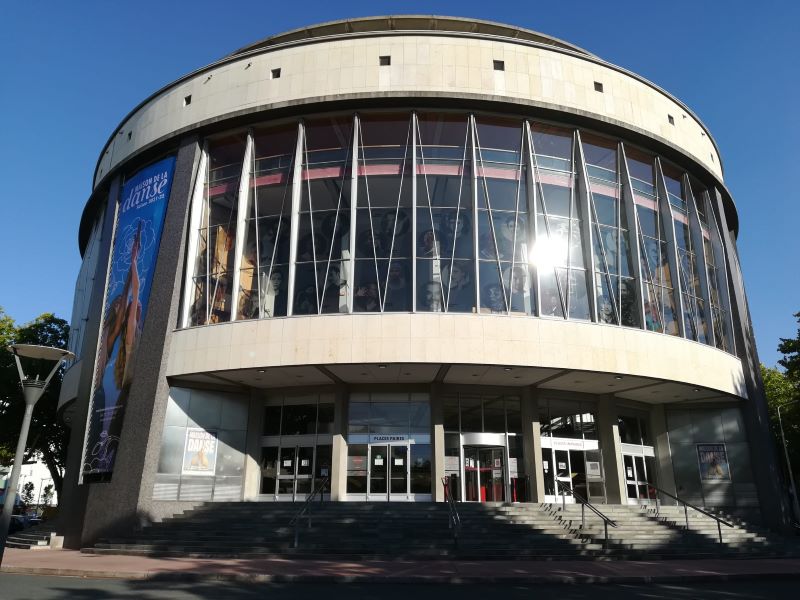
Maison de la Danse, Lyon
What developments do you hope this experience will usher in? What ideas and suggestions did it proffer towards your artistic studies?
S.T. As far as I’m concerned, the most concrete thing that this meeting brought was another such meeting: the fact that we can still have the opportunity to share our professional lives in these ways. So the most concrete outcome is “meeting each other” again.
F.D. For me too the significant thing was to meet each other. Because if there is no European dance, there are still European problems, those that are commonly shared. One of the greatest difficulties in my work – and it is a shared difficulty, as we discussed in Lyon – is that of being able to make people understand and legitimise the fact that artistic work does not begin and end with going on stage. In short, nothing new: there is that procedural and study aspect, seemingly unrelated to production, which however serves the end result, because without it you get to something that has its own quality and specificity. This is a common problem. This meeting was a response, a space for sharing. It served this purpose. It was an exchange of practices, information and skills, sharing difficulties and possible solutions.
We had not set ourselves the goal of drawing up a manifesto by the end of those three days or of solving a set problem. Over that time everything seemed to have remained as before, even if we well know that this is not the case at all. Because in this exchange we have trained ourselves to think collectively. As artists we don’t just sitting around a table and think but we mediate with the body. The training in collective thinking was not only in verbal discussion but also in practice, in moving and spatialising those questions and issues through the body. This objective had been achieved and was already inherent in the proposal. Therefore, I very much agree with Stefania that, if we want to think about a continuation, I look forward to further meetings like this one.
Interview by Anna Trevisan
English translation by Jim Sunderland
Cover image: Stefania Tansini; Francesco Dalmasso photographed by Cristina Da Ponte
TESTO IN ITALIANO
Stefania Tansini l’avevamo vista danzare quest’estate per BMotion Danza 2021 nel suo incisivo assolo “La grazia del terribile”. Un piccolo cameo, una scintilla esiziale e incarnata delle parole della stessa Tansini:
“La danza, un corpo che danza non esprime il mondo. Esprime quello che lui sa sul mondo. […] Il corpo del danzatore […] può essere una porta d’accesso di un discorso che lo trascende”.
L’inizio icastico del suo solo, scolpito in pose precise e meditate, si era sciolto in un cupo e progressivo disfacimento della forma, risolvendosi in uno smarrimento disorientante. Il suo corpo scosso da sussulti, tremante, quel suo colare liquido e denso si era riflettuto sul pubblico come una gigantesca e spaventosa ombra, come un’allucinazione, come un terribile doppio. Di quell’incontro artistico oggi rovesciamo le premesse, intervistando quest’artista via Zoom e “costringendola” a verbalizzare la sua magmatica danza.
Insieme a lei abbiamo intervistato Francesco Dalmasso, dance-maker e curatore versatile, brillante e creativo, selezionato dalla Lavanderia a Vapore nell’ambito del progetto Boarding Pass Plus Dance come rappresentante della scena piemontese e italiana. L’occasione di questa scoppiettante conversazione digitale è nata dalla loro comune partecipazione a Cellule d’Essai, un’iniziativa lanciata dai coreografi Lola Maury e Benjamin Coyle per artisti e coreografi europei, “per meditare sulla natura del lavoro del danzatore e sui suoi processi” che si è svolta a Lione presso la Maison de la Danse.
Stefania, per rompere il ghiaccio ti chiedo di raccontare i punti salienti della tua esperienza formativa.
S.T. Tra le esperienze che considero per me formative ci sono prima di tutto quelle in Accademia, alla Paolo Grassi, con artisti come Dominique Dupuy, Maria Consagra, Enzo Cosimi. Fuori dall’Accademia, ci sono quelle di quando ho cominciato a lavorare con Luca Vegetti e Simona Bertozzi. Con quest’ultima ho instaurato un rapporto molto profondo e duraturo. Poi ho incontrato Romeo Castellucci e ho avuto la fortuna di lavorare con Cindy Van Hacken come danzatrice. Ad oggi, come interprete, lavoro per i Motus.

Stefania Tansini in “La grazia del Terribile”, BMotion Danza 2021. Photo by Riccardo Panozzo
Incuriosisce il fatto che tu provieni dalla ginnastica artistica. Come è scoccata la scintilla per la danza?
S.T. Facevo ginnastica artistica in una palestra, avrò avuto sette anni. Mi piacevano tantissimo le parallele, le travi … ero molto fisica. Ad un certo punto, in questa palestra, hanno cominciato a fare anche lezioni di danza Anche se in quelle prime lezioni di danza mi annoiavo a morte, perché era una danza fatta male, dove tutto diventava posa estetica. Poi mi sono iscritta ad un’altra scuola di danza e ho ritrovato quella fisicità che mi era mancata durante quel primo corso amatoriale. Certo, la ginnastica ha dei principi diversi dalla danza. Ma, per l’approccio che io ho verso il corpo, per me è stato solo un passaggio di forma: ho sempre continuato a ricercare quei luoghi e quelle possibilità nei quali il mio corpo può esprimersi in maniera “densa”.
Per te invece Francesco come è nato l’amore per la danza? Ci racconti brevemente le tappe del tuo percorso formativo?

Francesco Dalmasso. Photo by Andrea Macchia
F.D. Ho cominciato che ero piuttosto piccolino: avrò avuto sei o sette anni. La mia è una storia comune a tante altre. La mia vicina di casa aveva una scuola di danza. Una sera è venuta da noi a cena e mi ha detto: “Se vuoi, puoi venire ogni tanto a lezione”. Ed è andata così. Sono originario di un paesino nelle Langhe ma poi, anche grazie all’apertura mentale di questa insegnante che mi ha sempre spronato a viaggiare, ho studiato anche a Torino e a Firenze. La mia esperienza più importante è però stata quella in Olanda. Lì ho studiato presso ArtEZ, dove ho conseguito il Bachelor Dance. Poi ho lavorato in Europa per qualche anno, principalmente come interprete: in Francia; in Germania; in Inghilterra e in Galles; in Lituania. Dal 2015 lavoro a Torino.

Francesco Dalmasso e Elisa D’Amico in “Virgolette”, NAOcrea 2019. Foto di Bing Xuan Li
Nel mio approccio alla danza c’è sempre stato un elemento che penso sia stato incoraggiato anche dal contesto olandese in cui ho studiato. Infatti, guardo il mondo della danza, che è il centro del mio interesse e della mia ricerca, da punti di vista diversi: storicamente e principalmente come interprete, poi come autore e insegnante e, negli ultimi anni, soprattutto come curatore e organizzatore. Penso a progetti come Shared Training Torino, piattaforma di condivisione di pratiche, e WorkSpace Ricerca X, che si occupa di ricerca artistica. Continua ad entusiasmarmi avere la stessa materia da approcciare da punti di vista diversi e slittando il ruolo.
Stefania anche tu hai un “doppio sguardo”: quello di interprete e quello di autrice e coreografa.

Stefania Tansini in “La grazia del Terribile”, BMotion Danza 2021. Photo by Riccardo Panozzo
S.T. Sono due sguardi diversi, quello dell’autore e quello dell’interprete, che seguono regole differenti pur giocando allo stesso gioco. Questo per me è molto interessante: sento che il mio cervello lavora diversamente quando a danzare sono io. Cambia la situazione, cambia il punto di vista: da interprete sei dentro al lavoro, sei dentro alla percezione che di te hanno gli altri. Lo sguardo coreografico invece guarda i corpi degli altri, in modo esterno. Mi interessa lo sguardo coreografico e autoriale, perché mi sembra una modalità molto ricca di connessione tra i corpi che osservo e tra lo spazio del mio corpo e quello degli altri. Il corpo ha già in sé una dimensione quasi drammaturgica ma lo sguardo del coreografo “fa esplodere” questa dimensione, la amplifica. È come se invece di leggere solo il primo capitolo di un libro si continuasse a leggere, e poi si leggessero altri libri ancora.
Quali sono i progetti ai quali state lavorando?
S.T. Sto lavorando ad un progetto modulare che si intitola My Body. Si divide in due. Da una parte c’è My Body in solo [che ha debuttato a Roma Europa Festival il 30 ottobre 2021, N.d.R.]. Invece l’altra parte del progetto si chiama My Body My Space. È un trio che ha previsto una serie di residenze fino a fine 2021, perché ha vinto il bando “Toscana Terra Accogliente”. L’anteprima sarà nella primavera del 2022. Questi sono due progetti concreti nei quali riesco a cristallizzare la mia ricerca e la mia visione sul corpo e sullo spazio.

Francesco Dalmasso in “TOWARDS per Isolotto”, Cantieri Culturali Isolotto, 2021. Photo by Francesca Ugolini
F.D. Con Elisa D’Amico, una collega con la quale collaboro da diversi anni, sono nella fase inziale di un lavoro che si intitola Towards. Il fulcro di questo lavoro è l’idea di andare “verso”/”towards”. È un lavoro figlio del Covid. L’intenzione del lavoro è nata da lì: dal desiderio di poter uscire finalmente di casa; di andare verso altri spazi, verso altri corpi, verso altri pensieri. Per il momento ha un orizzonte ampio di sviluppo: incontri, interviste, scritture condivise su Drive, pratiche fisiche, un lavoro per la scena…

Boarding Pass Plus Dance, Lyon, 2021
Veniamo alla vostra recente esperienza di lavoro con Lola Maury e Benjamin Coyle alla Maison de la Dance di Lione per il progetto europeo Boarding Pass Plus Dance? In che modo avete lavorato?
F.D. In quei tre giorni a Lione la struttura di base che ci è stata proposta è stata quella della mail-box, dove ciascuno di noi poteva imbucare dei foglietti con i propri pensieri. Era nata come ice-breacking e poi è diventata una modalità di lavoro per proporre al gruppo domande da discutere e da “spazializzare”.
S.T. Erano tante le cose che emergevano e il rischio era quello di perdersi in una diramazione infinita, perché ogni cosa diventava uno spunto di lavoro possibile. Ma anche solo accennare a queste cose, con la consapevolezza che non si poteva approfondirle tutte, era il sintomo del fatto che l’approccio a questi tre giorni funzionava. È stato un approccio molto aperto e libero, ma anche molto lucido, pragmatico e inclusivo. Ha incluso la possibilità di essere in disaccordo tra noi, di decidere quali tematiche lasciar cadere e quali affrontare.
C’erano artisti che provenivano da altri Paesi europei: chi da Londra, chi dal Belgio, chi dalla Spagna, chi dalla Francia. È stato interessante osservare come i nostri diversi background culturali si esprimevano, nostro malgrado, attraverso di noi, il nostro corpo e le nostre parole. Questo ha creato forse delle distanze ma ha comunque permesso degli incontri sia nelle parole che nelle azioni che nello “stare”. Per quanto mi riguarda, ci siamo accolti, pur nelle diversità. Nonostante tutto, c’è stato un dialogo su più livelli, sincero e molto vero, dentro al quale stavano le nostre intere esistenze. Tutte le persone che erano lì – me compresa -avevano la necessità di essere lì, perché la danza era ed è la nostra vita.

Boarding Pass Plus Dance, Lyon, 2021
Il fatto di provenire da mezza Europa, oltre ad aver prodotto una “collisione” di background culturali, vi ha dato anche la sensazione che esiste una grammatica comune nella danza contemporanea europea, un filo rosso, per esempio in termini di contenuti, oppure questa comunanza non la avete percepito affatto? Esiste una “danza europea” o -perdonate l’iperbole-è catastroficamente sbagliato anche solo cercare di parlarne?
S.T. Parlare di “danza europea” mi sembra un’espressione strana perfino da pronunciare. Concretamente, il terreno comune di incontro è la condizione in cui ci troviamo a lavorare. Il luogo comune è: “siamo tutti sulla stessa barca”. Noi tutti, come artisti indipendenti, in questo momento stiamo navigando a vista, in un sistema molto complesso, che è quello della produzione ma che comprende anche fasi non produttive e laboratoriali; che è fatto di interpreti ma anche di non-interpreti; che prevede la “danza” ma anche la “performance” e, per alcuni, anche lo “show”. Insieme abbiamo ragionato su quello che stiamo facendo. E questo non ha portato ad una risposta univoca ma molto frastagliata e complessa, determinata da moltissimi fattori, non solo legati alla danza, al fare danza, al mettersi in una sala prove e muoversi danzando ma anche al sistema che ruota intorno alla danza e che, inevitabilmente, influenza il nostro fare.

Maison de la Danse, Lyon
Che sviluppo vi augurate abbia questa esperienza? Quali spunti e suggestioni ha dato alla vostra ricerca artistica?
S.T. Per quanto mi riguarda, la cosa più concreta che può portare questo incontro è un altro incontro del genere: il fatto di poter avere ancora l’opportunità di condividere con queste modalità le nostre esistenze professionali. L’esito più concreto è di nuovo “incontrarsi”.
F.D. Anche per me il senso è stato quello di incontrarsi. Punto. Perché se non c’è una danza europea, esistono però problemi europei, quelli sì che sono comuni. Una delle difficoltà più grandi nel mio lavoro -ed è una difficoltà condivisa, come ci siamo detti in questi giorni a Lione- è quella di riuscire a far capire e a legittimare il fatto che il lavoro artistico non inizia e non finisce con l’andare in scena. Insomma, niente di nuovo: c’è quella parte processuale e di ricerca, piuttosto slegata dalla produzione, che però serve al risultato, perché senza di essa è molto difficile arrivare a qualcosa che abbia una sua qualità e specificità. Questo è un problema comune. Quest’incontro è stato una risposta, uno spazio di condivisione. È servito a questo. È stato uno scambio di pratiche, di informazioni e di competenze, di condivisione di difficoltà e di possibili soluzioni.
Non ci siamo dati l’obiettivo di stilare un manifesto alla fine di questi tre giorni o di risolvere un problema. In questi tre giorni tutto è rimasto come prima, anche se sappiamo bene che non è affatto così. Perché in questo scambio ci siamo allenati a pensare collettivamente. Noi come artisti pensiamo non solo seduti intorno ad un tavolo ma anche con il corpo. L’allenamento al pensiero collettivo era non solo nella discussione verbale ma anche nella pratica, nel muovere e nello “spazializzare” attraverso il corpo quelle domande e quelle questioni. Questo obiettivo è Stato raggiunto ed era già insito nella proposta. Perciò, sono molto d’accordo con Stefania che, se vogliamo pensare ad un proseguimento, mi auguro altri incontri come questo.
Intervista a cura di Anna Trevisan
Foto di copertina: Stefania Tansini e Francesco Dalmasso (fotografato da Cristina Da Ponte)



